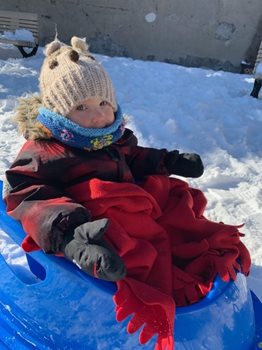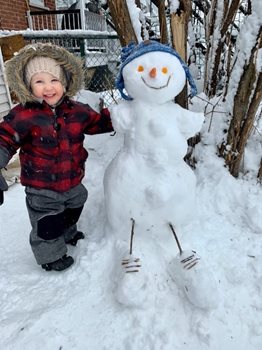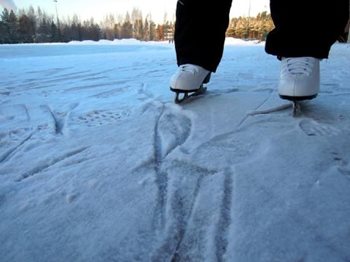Winter can bring lots of family fun, whether sledding and romping around in the snow or just hanging around together at home. This season isn't just a time to just stay indoors and wait for spring – there's a whole wonderland of outdoor activities for the entire family.
Cold weather, ice and snow can be fun but also dangerous for children. Here are a few tips to help keep your kids warm and safe during winter.
General winter safety tips
Check the weather forecast before children go outside and keep an eye on changing conditions throughout the day. The wind chill factor is important to watch for, to avoid the risk of frostbite on exposed skin. Also, during snowstorms, it’s safer for everyone to remain indoors – but assure the kids that some exciting snow games will happen once the storm has passed! If you make the decision to spend the day inside, here are some suggestions for activities for the whole family.
Finally, check often to see that your child is warm, dry and hydrated. It’s easy to get dehydrated without enough water, even during winter. Warm fluids keep their body temperature regulated.
Choosing the right clothes
 No matter the weather, kids have energy to burn. That means your little one will likely want to be outside burning off energy even when it’s below zero. While that’s a great thing for nap time, it also means you need to take extra care to protect them against the elements.
No matter the weather, kids have energy to burn. That means your little one will likely want to be outside burning off energy even when it’s below zero. While that’s a great thing for nap time, it also means you need to take extra care to protect them against the elements.Lay on light layers
The Canadian Pediatric Society offers this rule of thumb for winter weather dressing: put children in one more layer of clothing than an adult would wear in the same conditions.
Why? Layering also allows kids to remove a jacket or sweater, instead of having to choose between being overheated or freezing. Also, your child’s head, face, ears, hands, and feet are most prone to cold exposure and frostbite. Waterproof boots, waterproof gloves, a neck gaiter; and a hat all are key to keeping everyone toasty and warm on cold days.
Here are other tips:
- Choose mittens. If you’ve ever tried to put a glove on a kid’s hand so every finger is in the right place, you know it’s about as easy as putting a diaper on a goldfish. Stick with mittens, which are easier to slip on and are warmer because they keep fingers (and the heat they produce) close together.
- A warm hat is tops. A huge percentage of body heat is lost through the head, so a hat is a vital item in a kid’s winter wardrobe.
Throw on some shades
Sunglasses are important while playing outside in bright winter landscapes. Their little eyes are more sensitive than yours. Children are also at a higher risk of snow blindness than adults because their eyes’ crystalline lenses don’t block UV rays as effectively as those of a fully-developed adult.
Staying safe during winter play
 Active games, making snow angels and building snowmen will help to keep your child warm. Teach your children a few important rules to go along with winter play:
Active games, making snow angels and building snowmen will help to keep your child warm. Teach your children a few important rules to go along with winter play:- Stay away from snowplows and snow blowers
- Choose play areas away from roads, fences, open water and thin ice
- Take extra caution when crossing roads. It might be hard for drivers to see kids playing if they have snowy or frosty windows. Icy roads can also make it difficult for vehicles to stop
- Kids should not put metal objects in or on their mouth. Lips and tongues can freeze to the metal and cause injury
Approach snowball fights with caution
In the heat of the excitement, kids may not feel small rocks or pieces of ice hidden in snow during a snowball fight. However, if that snowball hits a child in the face, it could cause a significant injury. Parents can lay down some ground rules before the snowballs fly:
- Make sure snowballs are being made from fresh snow
- Set the boundaries of the physical space they can use for the snowball fight
- Be sure to supervise so you can intervene if something goes sideways
Supervise snow fort building
Kids love building spaces to call their own, including snow forts. Building them is a fun and constructive pastime, however, dangers exist that parents may not realize. The risk is that forts and snow tunnels can collapse with children inside and they can suffocate under the snow.
- If your child wants to build a snow fort, it is safest to build it without a ceiling. This way, if it collapses, the child will not be trapped.
- If your family does opt to put a roof on the fort, at least one adult should stay outside the fort supervising, so they can spring into action if anything dangerous happens.
Tobogganing and sledding
There is no better way to spend a winter’s day than swooshing down a sledding hill with the family. These tips will make your family’s next sledding adventure as safe as it is fun.
- Make sure your kids know about the hill where you will be playing so they are familiar with the area.
- Safety first! Always remember, helmets on heads.
- On the sled, sit feet first. Don’t sled while standing or facing headfirst - this greatly increases the risk of head or neck injury.
- Teach your kids to ride down the middle of the hill and return to the top by walking up the sides of the hill. Walking up the sides of a hill avoids collisions between those riding down and those climbing back up.
Ice hockey and ice skating
 Ice hockey and ice skating are great cold-weather activities that also require safety smarts.
Ice hockey and ice skating are great cold-weather activities that also require safety smarts.- All skaters should wear safety-approved hockey helmets. In Canada, a helmet should have "CSA" stamped on it.
- Skates should be comfortable, with good ankle support to avoid twists, sprains or breaks.
- Obey all signs posted on or near the ice for the security of your family.
- Never assume it’s safe to skate on a lake or pond. An adult should make sure the ice is at least 10 cm thick for skating alone or 20 cm for skating parties or games. Do not walk on ice near moving water like rivers and creeks – it may not be thick enough to be safe.
- The colour of ice can indicate its strength: clear blue ice is strongest; white opaque or snow ice is half as strong as blue ice; grey ice is unsafe.
Be safe on skis and snowboards
You don’t want to spend all your energy on the ski hill telling kids to slow down and be careful, right? Each year, children and adults are injured while skiing and snowboarding, and the injuries can be very serious.
If your children are new to skiing, sign them up for lessons with a certified instructor. They’ll learn safely and have loads of fun at the same time.
Safety on the slopes starts with the right equipment:
- Bindings should be properly adjusted. Rental or sales professionals can help choose equipment that is the right size and fit.
- Use only helmets that are specifically made for skiing or snowboarding.
- Eye protection is important to reduce glare from the reflection off the snow and to keep snow or ice from hitting the eyes while moving down the slopes at speed
- Wearing wrist guards and knee pads are a good way to help prevent bruises and fractures while snowboarding.
- Sunscreen and lip balm can protect against sunburn and windburn
Snowmobiling
Snowmobiling is a popular, fast-paced winter sport loved by many Canadians. Consider these important snowmobile safety tips:
- Children under age 6 should never ride on a snowmobile, even with an adult
- Children and youth under age 16 can be passengers but not drivers
- Never pull a child behind a snowmobile on a tube, sled or saucer
- Children and adults should wear approved helmets while riding, as head injuries are the leading cause of snowmobile-related deaths
Be watchful of common cold weather risks
During all the excitement of winter, two of the most common risks to watch for this season are frostbite and hypothermia. Being alert for their signs and symptoms can help your kids have a safer winter.
Signs of frostbite include pale, grey or blistered skin on the fingers, ears, nose, and toes. If this happens, you can help with these tips. Signs of hypothermia include shivering, slurred speech, drowsiness and unusual clumsiness. If you think your child has hypothermia, call 911 right away.
In winter, there are plenty of options for excitement and action. Talk with your family so that your kids know how to enjoy the snow while also staying safe!
The tips provided by our Prevention and Safety team are for reference only and are not a substitute for first aid training. Find a course near you. Download the free Red Cross First Aid app to always have practical resources at your fingertips.
Related stories:
- Snow day activities to entertain the whole family
- Different ways to play outside: discover new winter sports
- "Don't break a leg!" What to do in the event of sprains, strains and fractures

